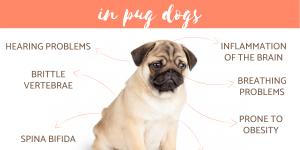Symptoms of Neurological Disorders in Dogs



See files for Dogs
A dog's nervous system is incredibly complex. Carrying signals from the brain to the rest of the body to control function and activity, even the slightest alteration can result in significant impairment. Dogs are susceptible to certain neurological disorders just as we are. When these neurological issues in dogs occur, they will display certain signs and symptoms which can help us to detect a problem early.
Detecting any neurological issues in our dog as soon as possible is imperative. In this way we can take them to the vet to be appropriately diagnosed and a treatment plan can be enacted. At AnimalWised we show you the major symptoms of neurological disorders in dogs. By looking a these 7 signs of neurological issues, you can see if you need to take action.
Neurological disorders in dogs
Although any dog can be affected by neurological issues, older and senior dogs are those most affected. This is partly due to the degeneration of brain tissue which can occur over time. Whether our dog will develop neurological disorders will depend on various factors, many of which are still unknown to veterinary science. While there are genetic influences which can be detected[1], they are not always available to all guardians.
Neurological issues in dogs can also be acquired. They are not always well understood and many dogs which develop neurological problems never have their cause determined. Although aging is an important factor, there are also pathogenic influences on neurological deterioration, even if further research is required to to determine their parthenogenesis[2]. With these factors in mind, some of the causes of neurological disorders in dogs include:
- Brain infections
- Systemic infections
- Head and spinal trauma
- Tumors
Although we cannot always know what has caused the canine neurological disorder, we do know there are various types. They include:
- Canine cognitive dysfunction (CCD)
- Epilepsy (seizures)
- Lumbosacral disease (LSD)
- Canine degenerative myelopathy (CDM)
Canine cognitive dysfunction is often correlated to Alzheimer's disease in humans. Sometimes spinal issues can be affected, as can any part of the dog's body. This is because the brain controls movement and general function of the organism. For this reason, the symptoms of neurological disorders in dogs can be varied. They manifest both physically and behaviorally. We look at the main signs of neurological issues in dogs in the sections below.
1. Weakness or paralysis of the extremities
Paralysis in the extremities is one possible sign of a neurological disorder in dogs, particularly with older canines. Extremities refers to their limbs and appendages, i.e. a dog's legs, paws and tail. Along with weakness in these areas, the dog may also experience pain in one or more limb. If so, this is usually the sign of a degenerative problem due to chronic wear and tear of the joints. However, it can also be a neurological issue which can lead to either paresis (weakness in voluntary movement) or plegia (paralysis of voluntary movement).
If this partial weakness affects the dog's hind legs, it is known as paraparesis and tetraparesis (or sometimes quadriparesis if affecting all four limbs). You may not have heard of these conditions, but there are in the same family as paraplegia (the complete loss of motor function in the lower body) with which you may be more familiar.
This partial or total loss of movement can be caused by an advanced state of degenerative joint disease in which the compression of the spinal cord occurs. Other variables such as infections, trauma, herniated discs or age can also be factors. This is why it is essential for an accurate diagnosis in order to find the root cause. Only then can appropriate treatment can be implemented. The wrong treatment could even make the situation worse.
If your dog shows signs of intermittent lameness, weakness of the front or hind quarters, lack of desire to move, experiences pain when their hip is touched, shakes in their knee joints or, worst of all, when they cannot stand up, it is important to see a vet so they can carry out the appropriate tests.
Most likely they will perform a complete scan (both physical and neurological) with imaging tests such as x-rays and CT/MRI scans. However, further laboratory tests such as spinal tap may also need to be undertaken.

2. Seizures
There are two main types of seizures in dogs:
- Partial: changes in motor function may occur such as a tremor in the head, contraction of limbs, involuntary jaw movement, etc. They may or may not be accompanied by alterations in behavior such as ‘fly snapping’ (chasing imaginary flies), barking for no reason, chasing their tail or showing uncommon aggression. Partial seizures can become more widespread.
- Generalized: in this type of seizure motor function impairment also occurs, but to a greater extent. Limb contractions become more acute, their neck can become stiff, they open and close their mouth or they pedal their legs. Vegetation can even occur once sufficient brain damage has occurred. They may also urinate or defecate involuntarily, salivate excessively and even lose consciousness.
Before and/or after the seizure, the animal may become restless, aggressive or engage in compulsive licking. If your dog has a generalized seizure which lasts more than 2 minutes or increases in frequency and severity, we need to urgently take them to a vet. You may find that they do not recover to their normal state after a bad seizure.
When you take them to the vet, they will be able to run the appropriate tests for a diagnosis. With seizures, many people will rightly consider the possibility of epilepsy, but vascular problems, metabolic alterations, toxic shock or trauma are also possible underlying causes.
3. Alterations to their gait
Perceiving alterations in the way the dog walks can be a sign the dog is suffering from a neurological condition. Abnormalities in their way of walking can manifest themselves as:
- Ataxia or incoordination: this is a type of change to a dog's gait which means their limbs lose their coordination. They may lean to the side, deviate at random or even appear to drag some of their limbs across the ground as they walk. This type of alteration could be due to injuries in different areas of the nervous system and it is important to find the location of the problem to help treat it.
- Moving in circles: this is usually associated with other symptoms and may be cause by multiple injuries throughout the nervous system. Dogs might walk or run in circles during play or going to bed. This is why it is important you distinguish between normal and abnormal movements. You can tell when it is abnormal as the dog will not seem to have control over their movement and does it continuously.

4. Altered mental state
In cases were there is an alteration in the central nervous system (i.e. the brain and brain stem), it is common for the animal's mental state to also change. We may see them faltering, barely interacting with their environment or pressing their head against the wall or furniture. There are many different manifestations of an altered mental state.
In general, a healthy animal will be alert and able to respond well to stimuli in their environment. If they have a neurological problem, their state of mind may be depressed. They can appear drowsy when awake, alternating between periods of inactivity with brief periods of activity. They may also be stuporous. This means they are awake, but appearing asleep and only responding to nociceptive (painful) stimuli.
One of the most severe symptoms of neurological disorders in dogs is a comatose state. This means the dog is alive, but unconscious and unresponsive to any stimuli. These symptoms may be accompanied by other behavioral changes, some of which may appear as if the dog is simply acting strange. If they do so without a specific cause, it may be due to a neurological issue.
5. Cocked head
Head cocking may be accompanied by other symptoms such as strabismus (crossing of the eyes), pathological nystagmus (involuntary and repetitive shaking of the eyes in horizontal, vertical or circular movements), moving in circles, hearing loss or imbalance. It is often associated with an injury to the inner ear known as canine vestibular syndrome. If your dog is of advanced age and/or has sever otitis and you notice they tilt or cock their heads, you need to go to the vet to asses their condition and make a diagnosis.

6. Generalized tremors
If your dog exhibits tremors for non-physiological reasons (e.g. it is very cold), it should alert us to something being wrong. If it presents with other symptoms mentioned in this article, you should go to the vet. However, the problem may not necessarily be physical as there might be emotional or mental concerns.
7. Alteration of the senses
In addition to the aforementioned signs of neurological disorders in dogs, changes to their senses may occur. These may include:
- Smell: the dog shows no interest in something unless they hear or see it. If they do not track when outside, cannot detect when we are holding treats they can't see or if there is a strong smell near them which they seem to ignore completely, there may be a problem with their olfactory nerve. If we place a smell next to them they normally would hate, such as vinegar, then it is likely they have a problem with their smell.
- Vision: there are different nerves involved with sight. If we suddenly detect our animal seems unable to see properly the vet will need to do a complete neurological and ophthalmological exam. If your dog can't see, you will notice them bump into things, not pay attention to you, not meet your gaze, etc.
- Hearing: especially with age, dogs will lose the acuity of their hearing due to wear of the ear's structures. However, it can also be a sign of neurological problems. They will often be accompanied by balance problems as the sense of hearing and coordination are related.
- Difficulty swallowing: can also be accompanied by sialorrhea (hypersalivation) or facial asymmetry.
- Touch: an animal with a neurological disorder at the spinal level can lose sensitivity when it comes to touch, in addition to having problems with motor function. They may also be extra-sensitive to our touch or wince in pain at something which would otherwise normally be well tolerated. Equally, they may lose their sense of touch and not respond to stimuli at all.

What should I do if I think my dog has neurological problems?
We have mentioned it throughout this article, but we say it again to emphasize its importance. If you think your dog has a neurological condition, go see a vet. Only they will be able to perform the right tests to achieve the right diagnosis.
Unfortunately, degenerative neurological disorders cannot be cured. We cannot reverse the damage which has been done to brain tissue. However, we can slow the degeneration and manage symptoms to improve quality of life. Diagnosing and treating the condition as soon as possible is the best way to ensure a decent prognosis. In cases of severe neurological disorder, it may be more kind to euthanize the dog.
Since signs of neurological disorder are more common in senior dogs, we need to provide them with special care. Learn more what this may involve with our video below:

This article is purely informative. AnimalWised does not have the authority to prescribe any veterinary treatment or create a diagnosis. We invite you to take your pet to the veterinarian if they are suffering from any condition or pain.
If you want to read similar articles to Symptoms of Neurological Disorders in Dogs, we recommend you visit our Prevention category.
1. Mellersh C. (2014). Inherited neurologic disorders in the dog: the science behind the solutions. The Veterinary clinics of North America. Small animal practice, 44(6), 1223–1234.
https://doi.org/10.1016/j.cvsm.2014.07.011
2. Vite, C. H., & Head, E. (2014). Aging in the canine and feline brain. The Veterinary clinics of North America. Small animal practice, 44(6), 1113–1129.
https://doi.org/10.1016/j.cvsm.2014.07.008










